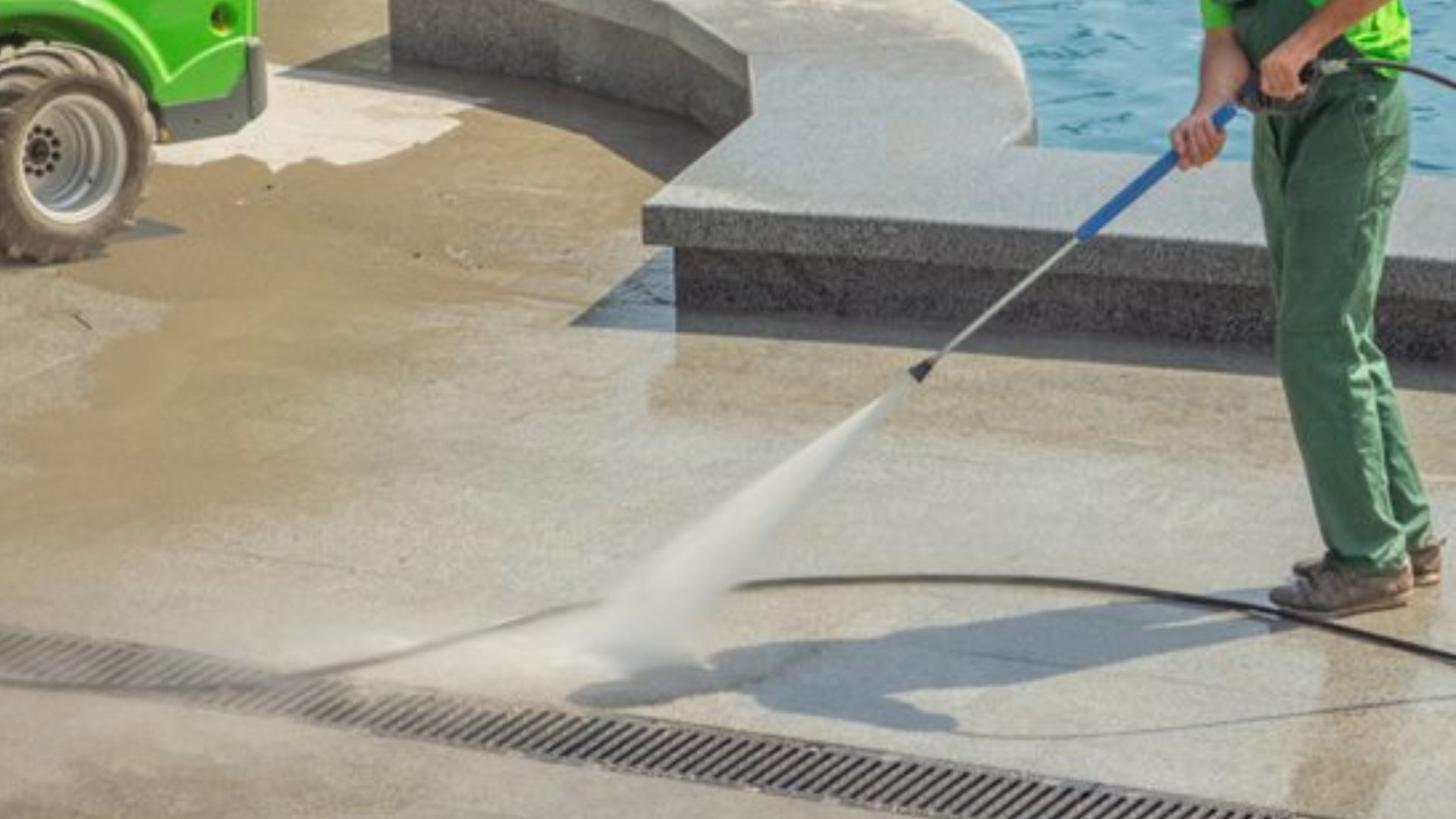A clean concrete pool deck makes your whole backyard look better, and it’s safer, too. Dirty pool decks can grow algae, mold, and mildew, which can make the surface slippery and dangerous.
If your pool area is looking stained, grimy, or just plain dull, don’t worry, you’ve got options.
You don’t always need a power washer to get the job done. In fact, there are several simple and affordable ways to clean your concrete pool deck, no matter what tools you have at home.
Whether you’ve just moved in, are getting ready for summer, or simply want a refresh, this guide is for you. I’ll walk you through easy, step-by-step methods to make your pool deck sparkle again.
Why It’s Important to Clean Your Concrete Pool Deck?
Concrete pool decks go through a lot. They’re constantly splashed with water, exposed to harsh sunlight, and often covered with dirt from bare feet, fallen leaves, and other outdoor debris.
Over time, this regular wear and tear can cause slippery surfaces due to algae or mildew buildup, unsightly stains from rust, dirt, or sunscreen, as well as fading or patchy discoloration.
A dirty deck can quickly make the whole area feel worn out and uninviting. Cleaning it regularly not only keeps the space looking fresh and well-kept, but it also helps prevent slips and falls, keeping your family and guests safer around the pool.
Regular maintenance also helps preserve the quality of the concrete, reducing the need for expensive repairs. It can extend the life of any sealant or coating you’ve applied.
Plus, a clean deck simply makes the entire pool area more enjoyable and relaxing.
Step-by-Step Guide: How to Clean a Concrete Pool Deck
Cleaning a concrete pool deck involves more than just spraying water around, it requires planning, the right tools, and careful attention to detail.
Tools Needed
A mix of basic cleaning tools and optional equipment to make the job faster, easier, and more effective.
- Pump sprayer or soft wash system
- Bleach (3%–4% sodium hypochlorite)
- Garden hose or low-pressure washer
- Whisper Wash surface cleaner
- Stiff broom (manual option)
- Plastic covers for property protection
- Leaf blower or broom
Step 1: Assess the Work Area
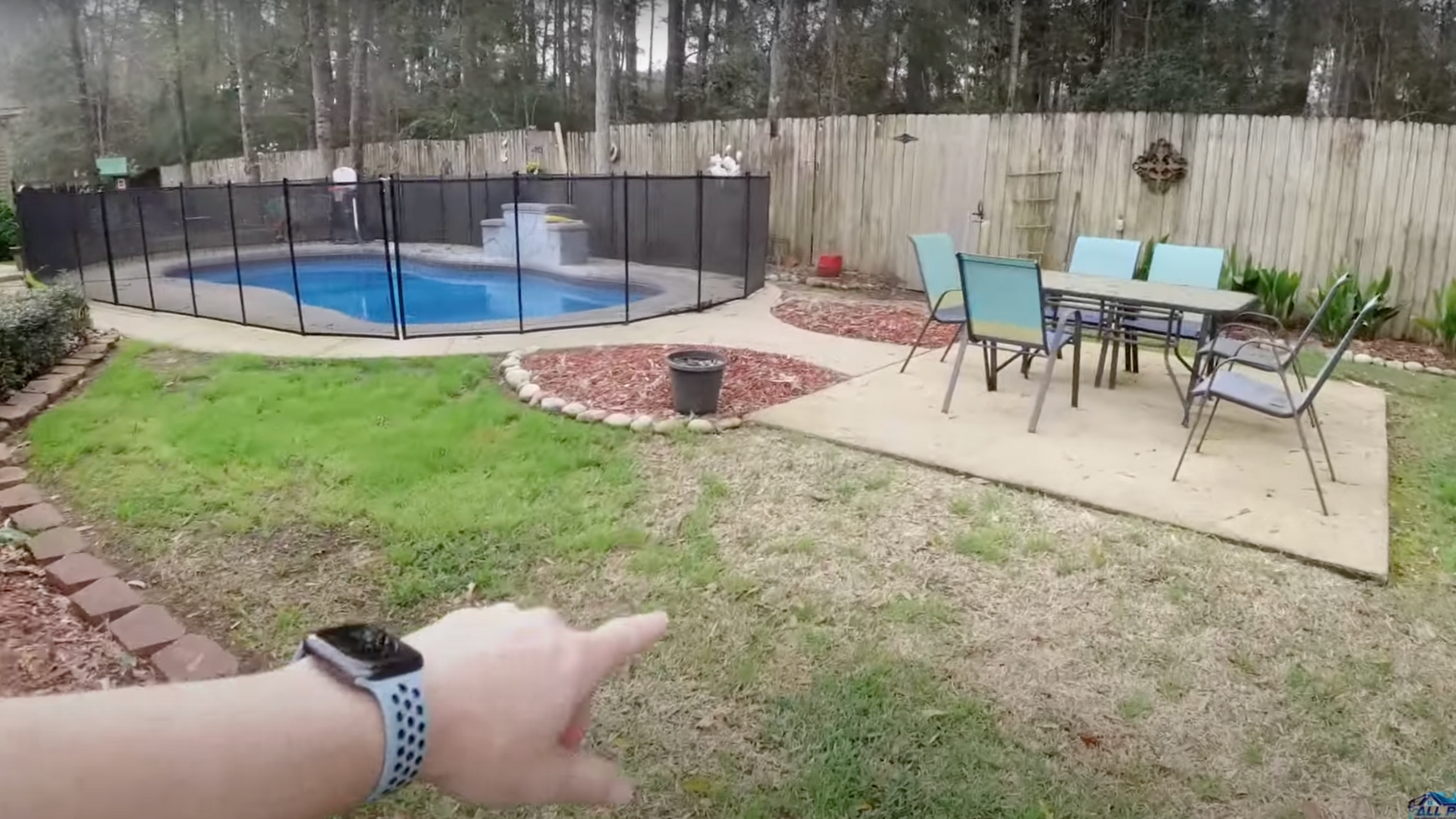
Before doing any cleaning, walk around the area and evaluate the job.
Check what kind of surfaces you’re working with, like flat concrete slabs, textured finishes, or areas close to plants and windows. This helps determine what tools and solutions are safe to use.
Step 2: Clear the Area
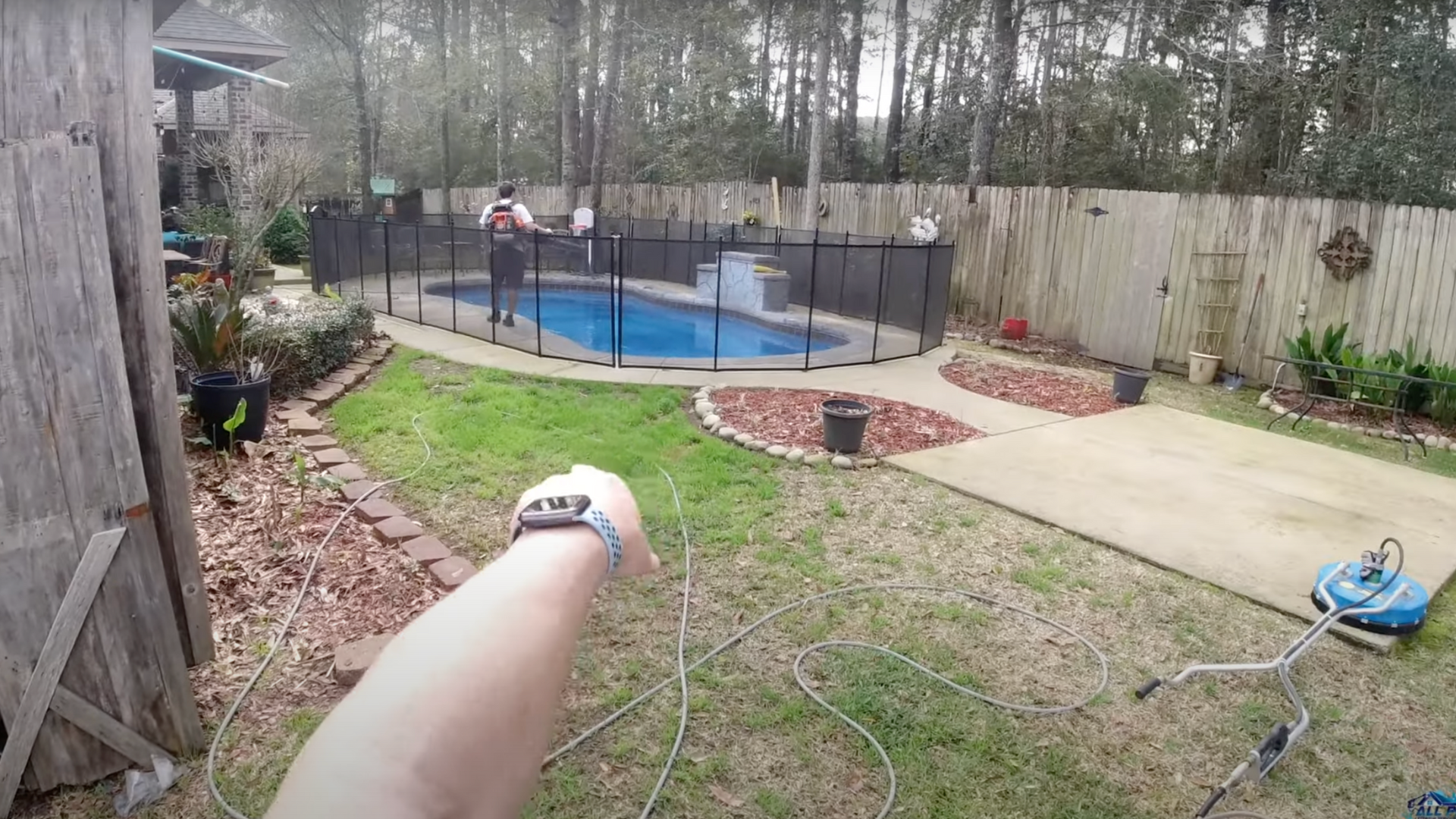
Move furniture, planters, hoses, and other obstacles away from the concrete surface.
Safety comes first – moving things out of the way prevents damage and makes cleaning more effective. It also gives you a clear view of the entire area, so you won’t miss any spots.
Step 3: Protect Nearby Property
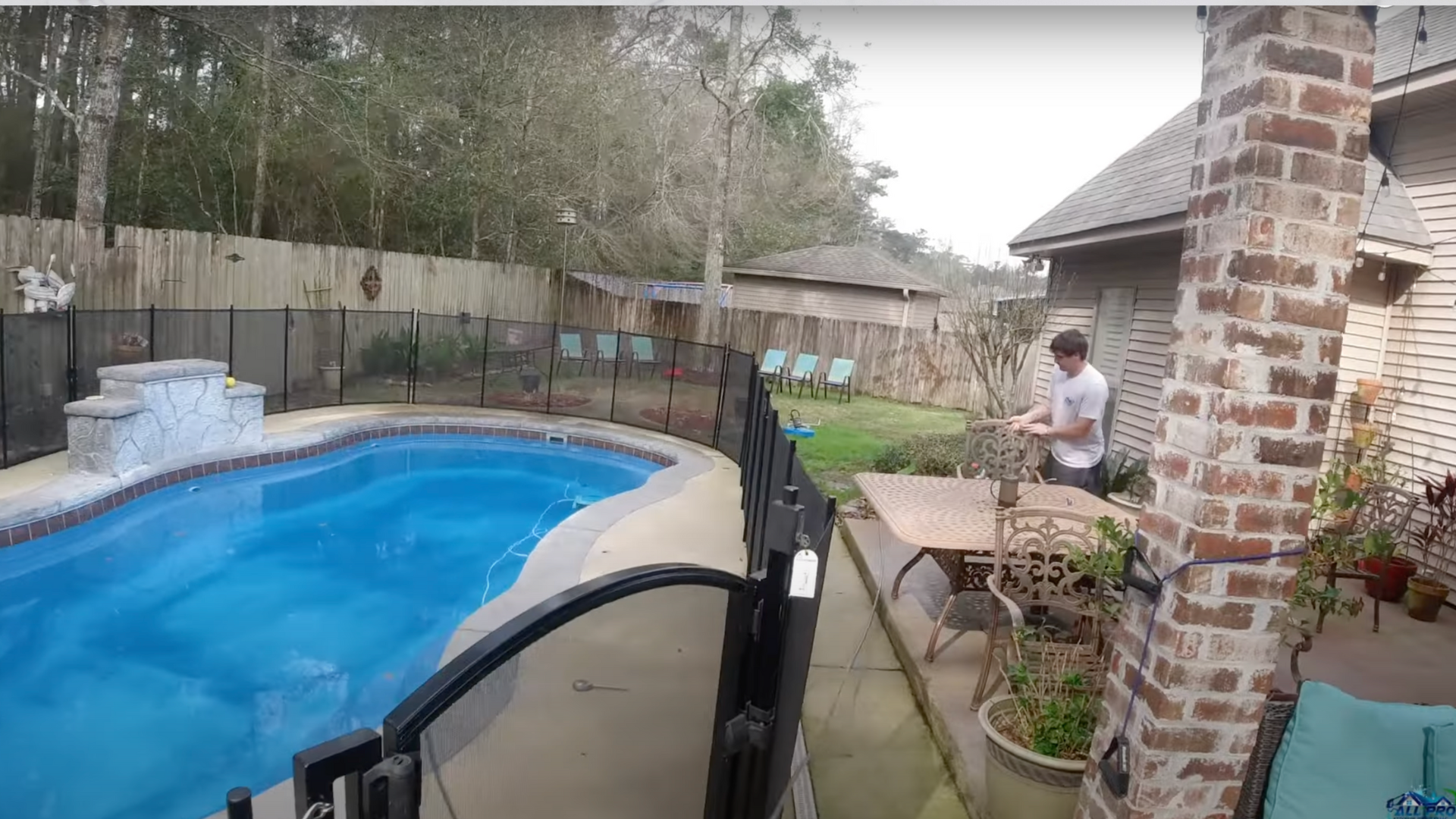
Before applying any chemicals, protect sensitive areas such as plants, doors, and walls. Consider using drop cloths or covers to shield delicate landscaping or glass.
This extra step can help prevent stains, damage, or accidental spray on things you want to keep safe. Taking a few minutes to prep can save you a lot of cleanup later.
Step 4: Apply a Cleaning Solution
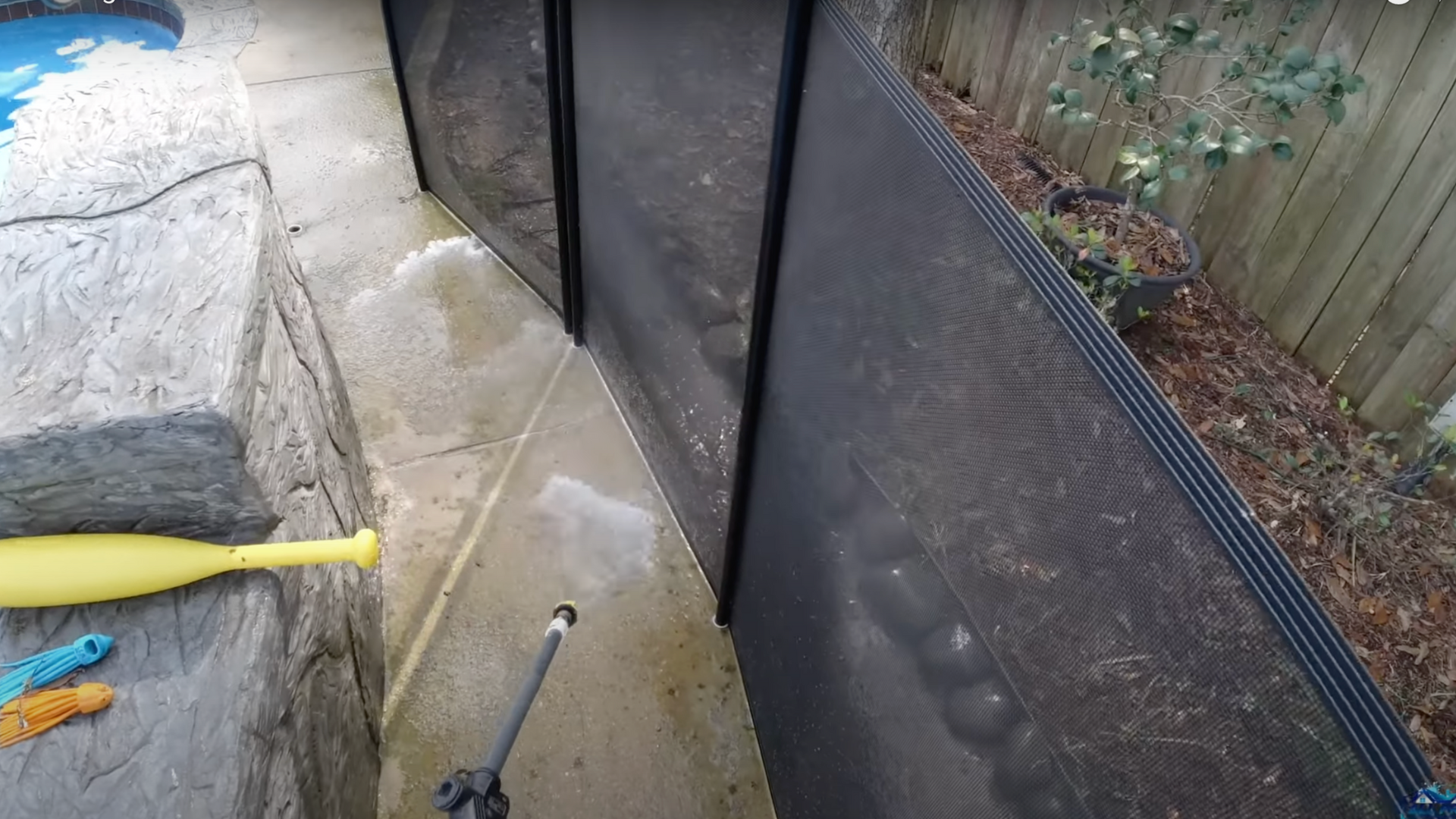
Use the soft wash method with a solution of about 3%–4% sodium hypochlorite (bleach) to treat the pool deck. Spray the solution around the concrete, focusing on dirty and algae-covered areas.
Letting the mix “sit and marinate” for a few minutes helps break down grime, mold, and mildew.
Important: Always check if your concrete can handle bleach. Test a small area first if unsure.
Step 5: Scrub or Surface Clean (If Needed)
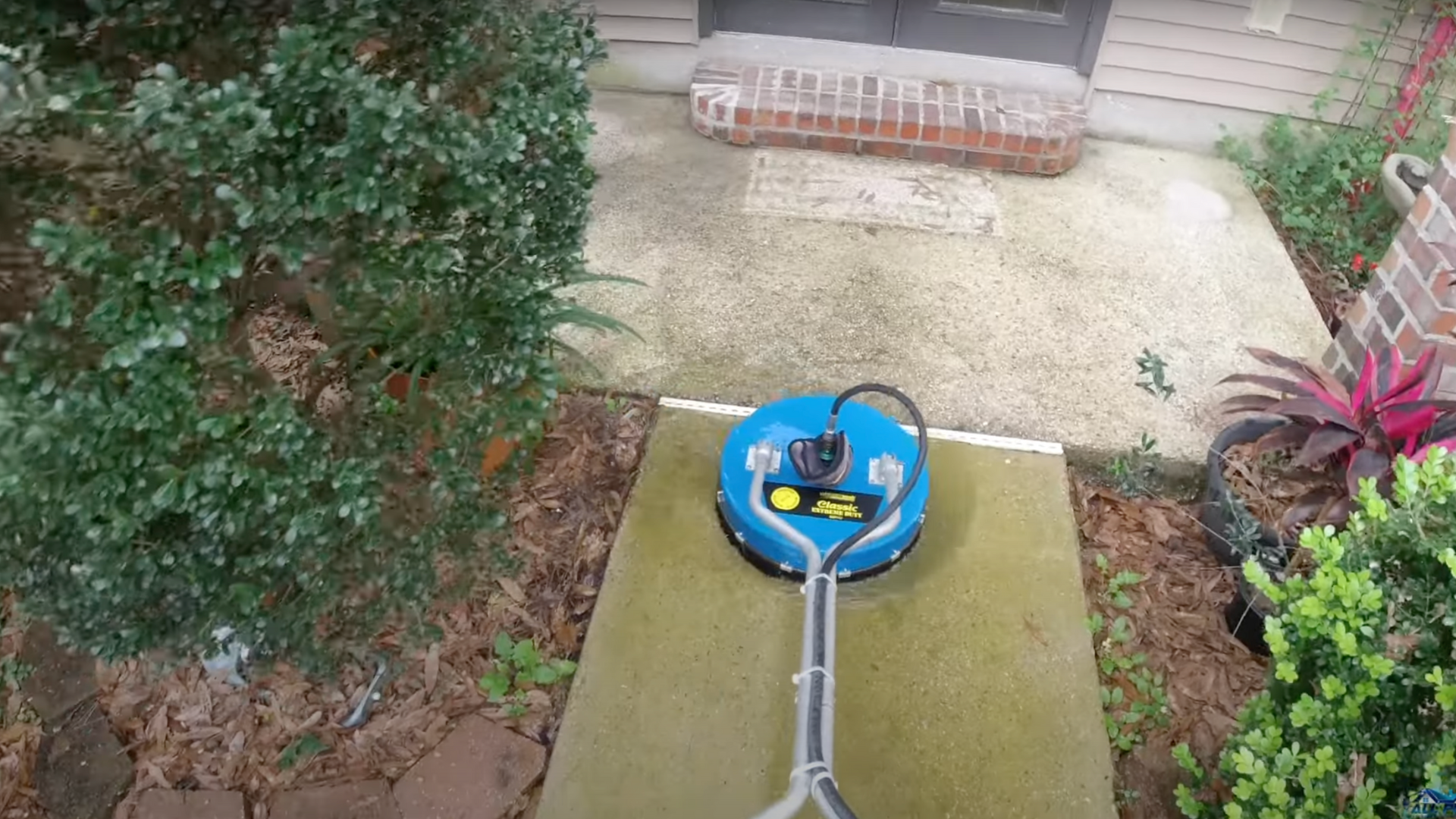
In flat open areas, use a Whisper Wash surface cleaner to thoroughly clean the concrete.
Take caution around the pool’s edge and do not use the machine close to water features or delicate materials. If you’re cleaning manually, a stiff broom and some elbow grease will do the trick.
Tip: Avoid using a surface cleaner on surfaces that aren’t solid concrete, as it may damage coatings or decorative textures.
Step 6: Rinse Thoroughly

After the solution has set and done its work, rinse the concrete using clean water. Rinse the pool deck completely to wash away all the cleaner.
This is important to remove any leftover chemicals and make the area safe for foot traffic. Be sure to check corners and edges where residue might hide, and keep rinsing until the water runs clear.
Step 7: Check for Missed Spots and Re-Treat If Needed
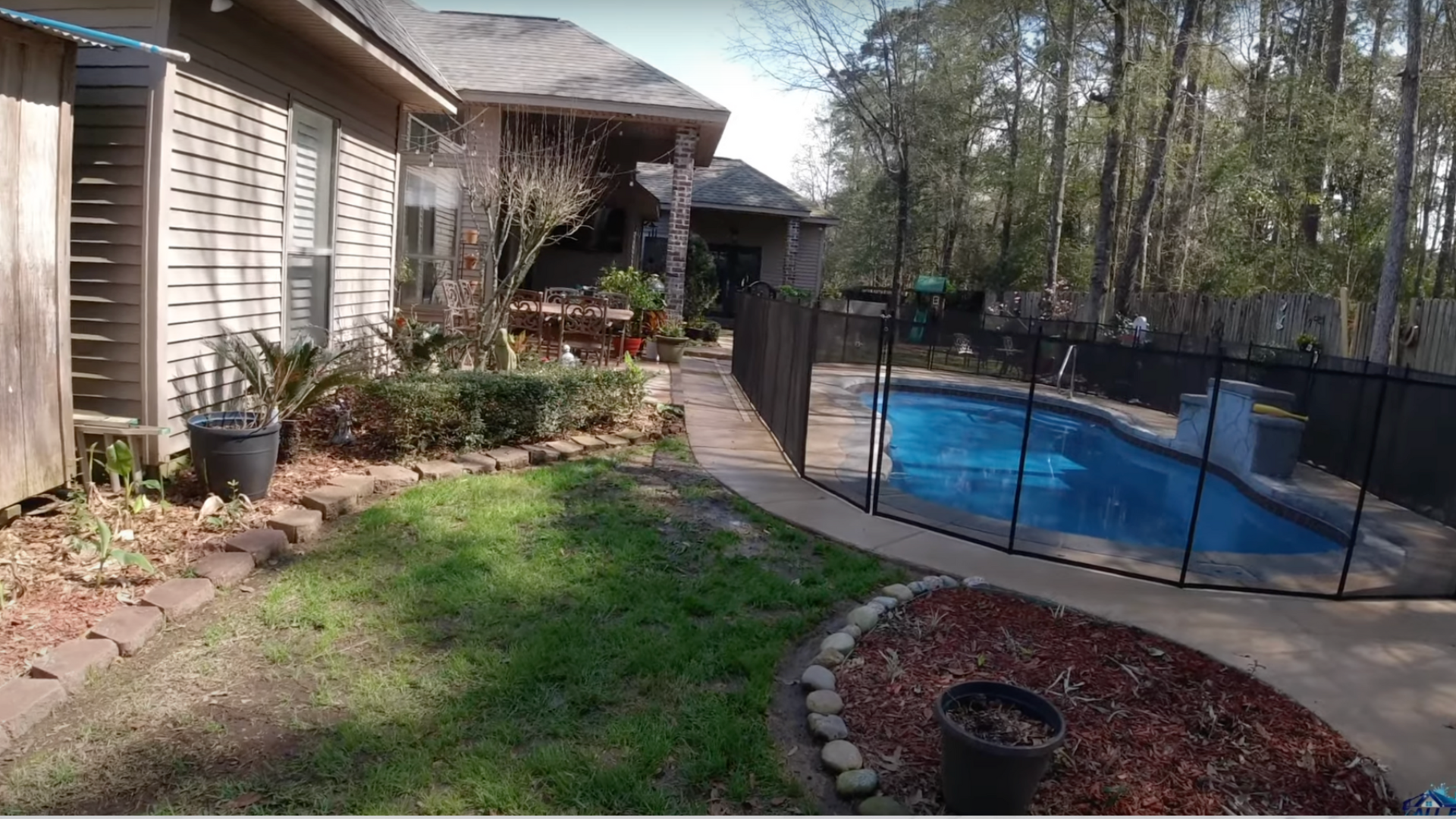
Sometimes one pass isn’t enough. Check any tough spots that needed extra treatment. Reapply the cleaning solution to stubborn areas, let it sit again, and rinse.
This step ensures your concrete deck looks even and bright throughout. Don’t rush – giving problem areas a second go can make a big difference in the final result.
Step 8: Final Walkthrough and Touch-Ups
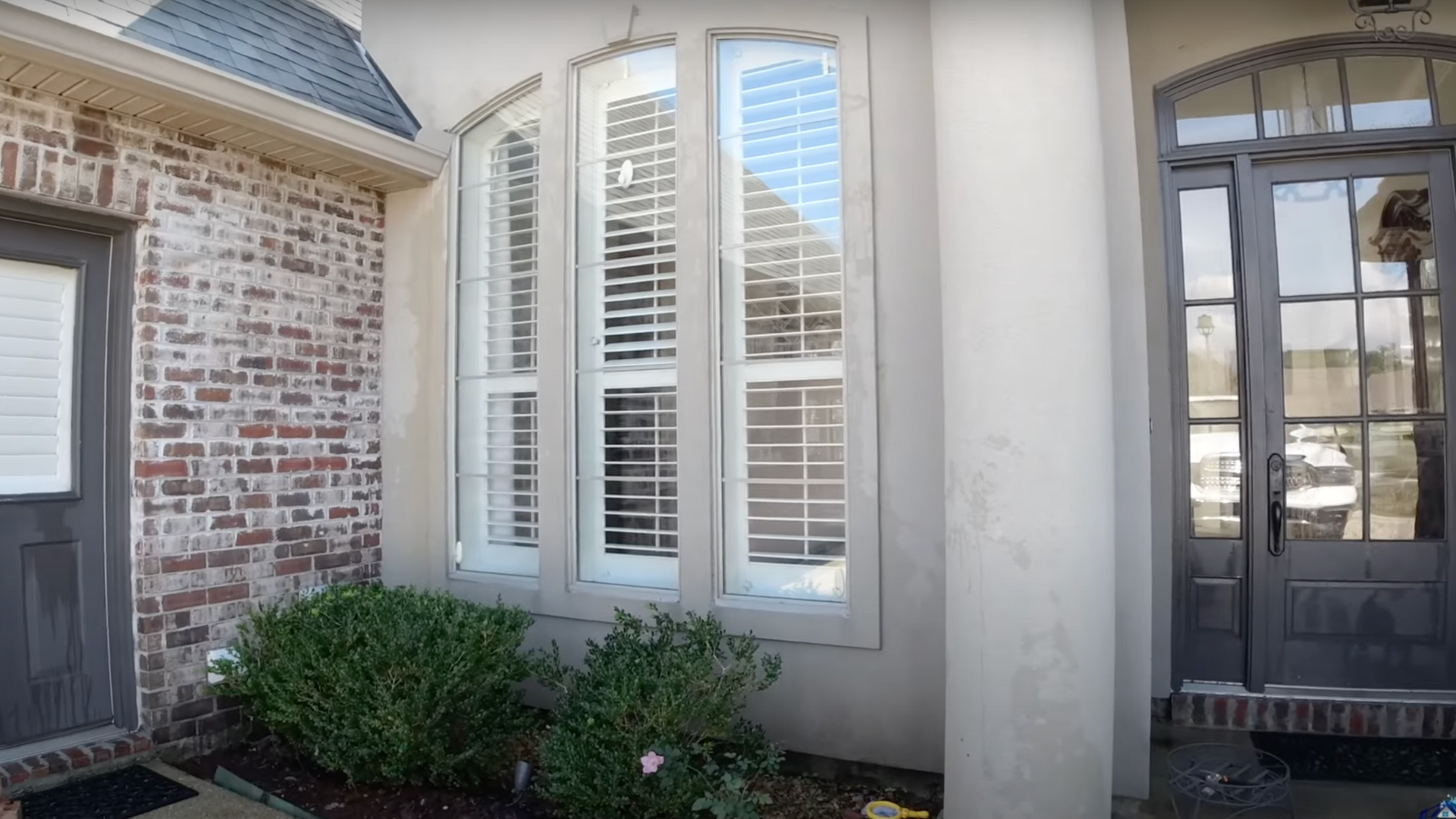
Once the cleaning is done, walk the area to inspect your work. Touch up corners, rinse off edges, and be cautious not to walk on wet areas to avoid leaving footprints.
Any remaining debris or water should be cleared away so the surface can dry evenly.
Concrete Pool Deck Cleaning Methods
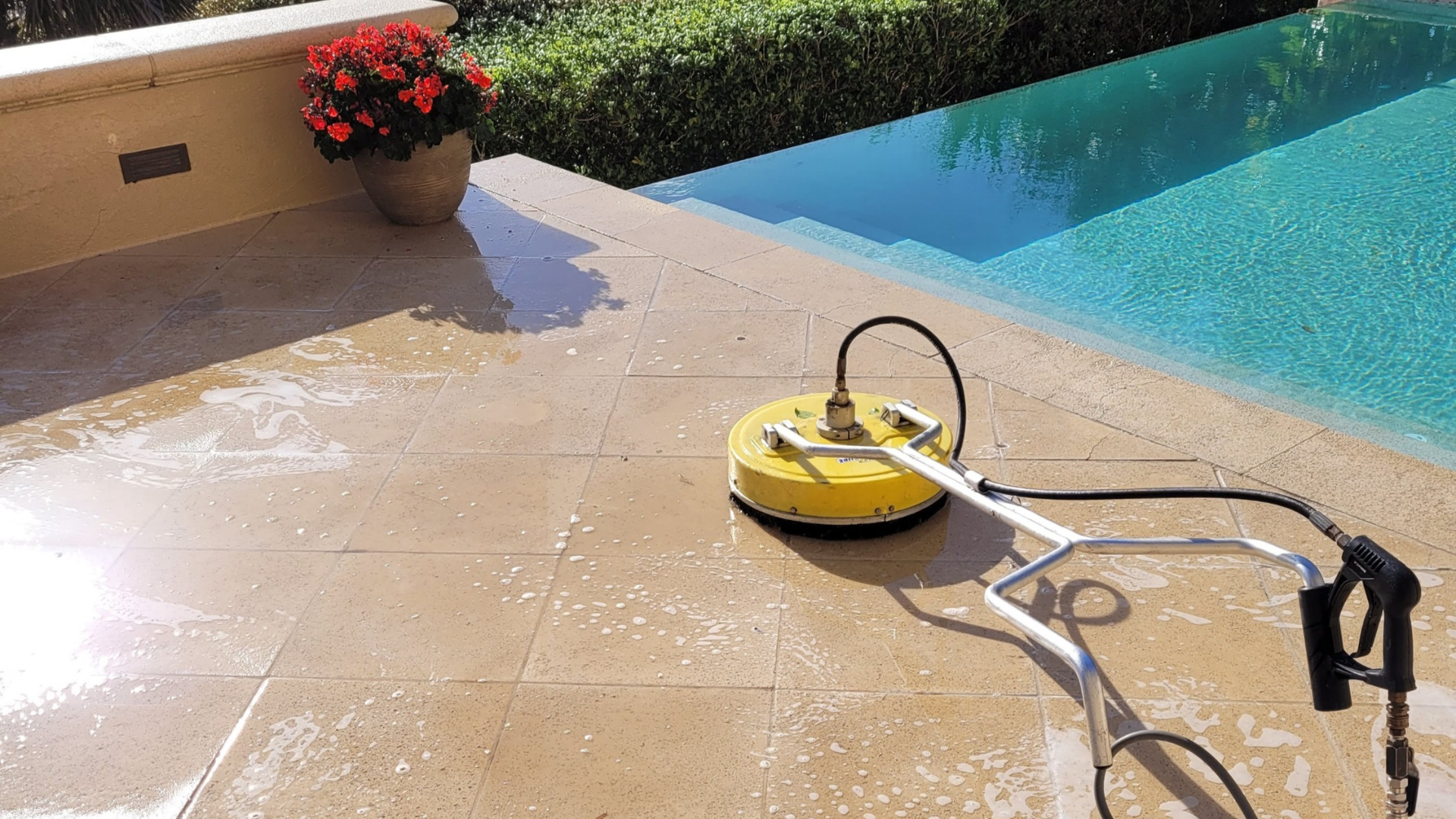
There’s more than one way to clean a concrete pool deck; some methods are great for quick maintenance, while others tackle deep grime or algae.
Method 1: Basic Soap and Water (Good for Light Cleaning)
This is one of the easiest and most budget-friendly ways to clean your pool deck. Start by sweeping away any loose dirt, leaves, or debris.
Then fill a bucket with warm water and add a few squirts of mild dish soap. Dip a broom or stiff-bristled brush into the soapy water and scrub the surface thoroughly.
Finish by rinsing the area with a garden hose. This gentle method is perfect for light dirt and is safe for all types of concrete. It also won’t harm nearby grass, plants, or flowers.
Method 2: White Vinegar and Water (Eco-Friendly)
White vinegar is a natural and eco-safe way to clean mildew, algae, and mild stains. Mix equal parts white vinegar and water in a spray bottle or bucket.
Apply the mixture generously to stained or discolored areas and let it sit for 15–20 minutes. Then scrub using a brush and rinse well with a garden hose.
This method not only lifts grime but also helps sanitize the surface without any harsh chemicals, ideal if you’re cleaning near children, pets, or plants.
Method 3: Baking Soda Paste (For Tough Stains)
Baking soda works wonders for tackling specific tough spots like rust, sunscreen drips, or greasy stains.
To make the paste, combine baking soda with a small amount of water until it thickens. Apply it directly onto the stain and let it sit for 10 to 15 minutes.
Afterward, scrub the area using a brush and rinse thoroughly with clean water. This is a non-toxic and gentle solution that’s very effective on stubborn marks without damaging the concrete surface.
Method 4: Oxygen Bleach (Strong but Safe)
Oxygen bleach is a safer alternative to traditional bleach, especially around plants and pets. Mix the product with warm water according to the label’s instructions.
Pour or spray it across the pool deck and let it sit for 10 to 30 minutes, depending on how dirty the surface is. Scrub the area with a broom or brush to loosen any stuck-on grime, then rinse completely.
This method offers powerful cleaning without the strong smell or plant-killing effects of chlorine bleach, but always wear gloves while using it.
Method 5: TSP (Trisodium Phosphate) for Deep Cleaning
When your pool deck hasn’t been cleaned in a long time or has heavy grime, TSP is a tough but effective option. Mix ½ cup of TSP with 1 gallon of warm water.
Wearing gloves for safety, apply the solution to the concrete using a brush or broom. Scrub thoroughly and rinse off with a garden hose.
TSP cuts through deep dirt and buildup, but it’s a strong chemical, so be careful, don’t let it sit too long, and always follow package directions for proper use and disposal.
Method 6: Power Washing (Most Effective for Big Jobs)
Power washing is great for large decks or surfaces with serious buildup. Begin by sweeping the area to remove loose dirt. Hook up your power washer to a hose and spray the concrete using steady, overlapping motions.
Focus on stained sections, but avoid getting too close to the surface, which can cause damage.
Use a fan tip rather than a pinpoint nozzle to prevent etching. While this method delivers fast results, it’s not suitable for old, cracked, or sealed concrete, which may be too fragile for high pressure.
Method 7: Enzyme-Based Cleaners (Pet and Plant Safe)
Enzyme cleaners are ideal for people looking for a natural, family-friendly cleaning solution. These products break down organic material like mold, mildew, and algae without harsh chemicals.
Choose a cleaner designed for outdoor surfaces and follow the mixing and application directions on the label.
Let the solution sit for the recommended time, then rinse with water. This is a great option if you want a clean deck without worrying about harming kids, pets, or surrounding garden beds.
Method 8: Deck Brush Attachment for Your Hose
If you don’t have a power washer but still want something more effective than a broom, a deck brush that attaches to your hose is a great tool. These brushes release water as you scrub, helping loosen dirt more efficiently.
Some models even have built-in soap dispensers to apply cleaning solutions as you work. This tool is especially handy for regular upkeep and light stains, offering a simple way to clean your deck with minimal setup.
When to Call a Pro?
Sometimes, a concrete pool deck needs more than just a good cleaning.
If you’re dealing with deep oil or rust stains that won’t lift, mold that keeps returning no matter how many times you clean it, or large cracks and visible surface damage, it’s best to call a professional.
These issues often require specialized tools, stronger cleaning agents, or repair techniques like acid washing or resurfacing, tasks that can be risky or ineffective if done without experience.
A professional service can assess the condition of your deck and restore it safely, saving you time, effort, and potential damage.
Hiring an expert also ensures that the work meets safety standards, particularly in areas such as water and electrical systems. Plus, a pro can apply protective sealants that help your deck stay cleaner for longer.
Extra Tips for Pool Deck Cleaning Success
I’ve found that a few smart habits can really make pool deck cleaning easier and help it look better for longer. These extra tips helped me avoid common mistakes and keep my concrete surface in good shape over time.
- Work in sections: Cleaning smaller areas one at a time helps you scrub more thoroughly and avoid streaks or missed spots.
- Choose a cloudy day: Direct sunlight can cause cleaning solutions to dry too quickly, reducing their effectiveness. Overcast weather gives you more time to work.
- Rinse well: Always rinse off soaps and cleaners completely. If left behind, they can attract dirt and make the surface sticky.
- Seal your deck once a year: Applying a concrete sealer annually helps block stains, resist water damage, and keep the deck color looking fresh.
- Stay ahead: Don’t wait for buildup. A quick clean every month or two keeps your deck in good shape and saves effort in the long run.
Conclusion
Cleaning your concrete pool deck doesn’t have to be a big job or an expensive one. Whether you’re using basic soap and water or a stronger cleaner like oxygen bleach or TSP, the key is to work in sections, rinse well, and stay consistent.
If you’re like me, you want your pool area to feel clean, safe, and welcoming for everyone who visits, especially your family.
Now that you’ve learned how to clean your concrete pool deck using several different methods (with or without a power washer), pick the one that fits your tools, time, and needs.
Let me know how your cleaning went or if you have a favorite tip that worked wonders. I’d love to hear about it; drop your thoughts in the comments or send me a quick message.


